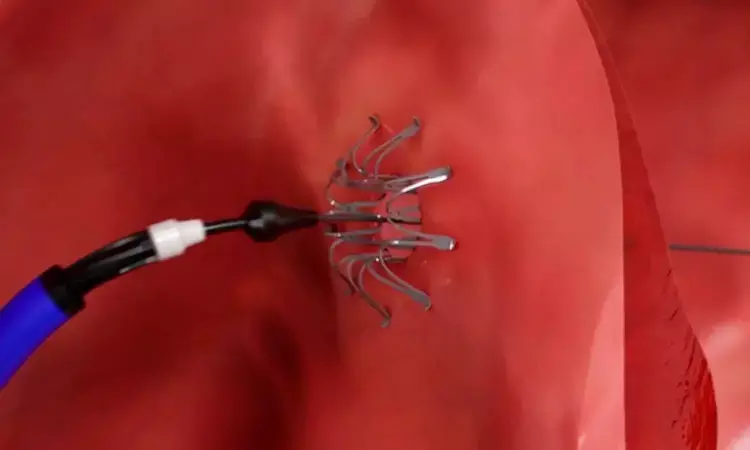- Home
- Medical news & Guidelines
- Anesthesiology
- Cardiology and CTVS
- Critical Care
- Dentistry
- Dermatology
- Diabetes and Endocrinology
- ENT
- Gastroenterology
- Medicine
- Nephrology
- Neurology
- Obstretics-Gynaecology
- Oncology
- Ophthalmology
- Orthopaedics
- Pediatrics-Neonatology
- Psychiatry
- Pulmonology
- Radiology
- Surgery
- Urology
- Laboratory Medicine
- Diet
- Nursing
- Paramedical
- Physiotherapy
- Health news
- Fact Check
- Bone Health Fact Check
- Brain Health Fact Check
- Cancer Related Fact Check
- Child Care Fact Check
- Dental and oral health fact check
- Diabetes and metabolic health fact check
- Diet and Nutrition Fact Check
- Eye and ENT Care Fact Check
- Fitness fact check
- Gut health fact check
- Heart health fact check
- Kidney health fact check
- Medical education fact check
- Men's health fact check
- Respiratory fact check
- Skin and hair care fact check
- Vaccine and Immunization fact check
- Women's health fact check
- AYUSH
- State News
- Andaman and Nicobar Islands
- Andhra Pradesh
- Arunachal Pradesh
- Assam
- Bihar
- Chandigarh
- Chattisgarh
- Dadra and Nagar Haveli
- Daman and Diu
- Delhi
- Goa
- Gujarat
- Haryana
- Himachal Pradesh
- Jammu & Kashmir
- Jharkhand
- Karnataka
- Kerala
- Ladakh
- Lakshadweep
- Madhya Pradesh
- Maharashtra
- Manipur
- Meghalaya
- Mizoram
- Nagaland
- Odisha
- Puducherry
- Punjab
- Rajasthan
- Sikkim
- Tamil Nadu
- Telangana
- Tripura
- Uttar Pradesh
- Uttrakhand
- West Bengal
- Medical Education
- Industry
Atrial Shunt Devices may Redefine Heart Failure Management: JAMA

USA: Heart failure with preserved ejection fraction (HFpEF) presents a complex clinical challenge, with limited treatment options compared to heart failure with reduced ejection fraction (HFrEF). However, recent advancements in medical technology have sparked hope in the form of atrial shunt devices, offering a novel approach to managing HFpEF.
The post hoc analysis of REDUCE LAP-HF II Randomized Clinical Trial sheds light on the long-term effect of an atrial shunt device on cardiac structure and function in patients with heart failure and preserved or mildly reduced ejection fraction.
The study findings published in JAMA Cardiology showed no evidence of right ventricle (RV) dysfunction over the initial two years and supported the previously identified responder group hypothesis.
"The post hoc analysis of the REDUCE LAP-HF II RCT comprising 621 patients found that atrial shunting led to reverse remodeling of left-sided chambers and increases in volume of right-sided chambers but no change in RV systolic function compared with sham," the researchers wrote.
They found changes in cardiac function/structure to be favorable in previously defined responders versus the nonresponders.
The results of the REDUCE LAP-HF II trial were neutral overall, however, atrial shunt therapy demonstrated potential efficacy in responders (no latent pulmonary vascular disease and no cardiac rhythm management device). Therefore, Ravi B. Patel, Northwestern University Feinberg School of Medicine, Chicago, Illinois, and colleagues aimed to evaluate the effect of atrial shunt vs sham control on cardiac structure/function in the overall study and stratified by responder status.
For this purpose, the researcher conducted a sham-controlled randomized clinical trial of an atrial shunt device in HFpEF/HFmrEF. Trial participants with evaluable echocardiography scans were recruited from 89 international medical centers.
The outcome measures were changes in echocardiographic measures from baseline to 1, 6, 12, and 24 months after the index procedure.
The modified intention-to-treat analysis of the REDUCE LAP-HF II trial comprised 621 randomized patients with a median age of 72.0 years; 61.5% were females; shunt arm, 309; sham control arm, 312.
The researchers reported the following findings:
- Through 24 months, 98% of patients in the shunt arm with evaluable echocardiograms had patent shunts.
- In the overall trial population, the shunt reduced left ventricular (LV) end-diastolic volume (mean difference, −5.65 mL), left atrial (LA) minimal volume (mean difference, −2.8 mL), and improved LV systolic tissue Doppler velocity (mean difference, 0.69 cm/s) and LA emptying fraction (mean difference, 1.88 percentage units) compared with sham.
- Shunt treatment also increased right ventricular (RV; mean difference, 9.58 mL) and right atrial (RA; mean difference, 9.71 mL) volumes but did not affect RV systolic function, pulmonary artery pressure, or RA pressure compared with sham.
- In the shunt arm, responders had smaller increases in RV end-systolic volume (mean difference, 1.58 mL versus 7.89 mL), RV end-diastolic volume (mean difference, 5.71 mL vs 15.18 mL), and RV/LV ratio (mean difference, 0.07 vs 0.20) and a larger increases in transmitral A wave velocity (mean difference, 5.08 cm/s vs −1.97 cm/s) compared with nonresponders randomized to the shunt, suggesting a greater ability to accommodate shunted blood through the pulmonary circulation enabling LA unloading.
In conclusion, the analysis showed that atrial shunting led to reverse remodeling of left-sided chambers and increases in right-sided chamber volume consistent with the shunt flow but no change in RV systolic function compared with sham.
"Changes in cardiac function/structure were more favorable in responders versus nonresponders treated with the shunt, supporting the previously identified responder group hypothesis and mechanism, although there is a need for further evaluation with longer follow-up," the researchers wrote.
Reference:
Patel RB, Silvestry FE, Komtebedde J, et al. Atrial Shunt Device Effects on Cardiac Structure and Function in Heart Failure With Preserved Ejection Fraction: The REDUCE LAP-HF II Randomized Clinical Trial. JAMA Cardiol. Published online April 17, 2024. doi:10.1001/jamacardio.2024.0520
Dr Kamal Kant Kohli-MBBS, DTCD- a chest specialist with more than 30 years of practice and a flair for writing clinical articles, Dr Kamal Kant Kohli joined Medical Dialogues as a Chief Editor of Medical News. Besides writing articles, as an editor, he proofreads and verifies all the medical content published on Medical Dialogues including those coming from journals, studies,medical conferences,guidelines etc. Email: drkohli@medicaldialogues.in. Contact no. 011-43720751


